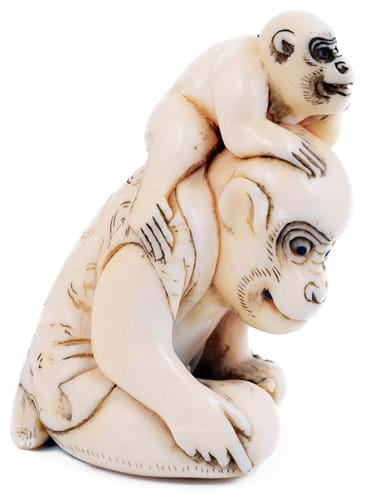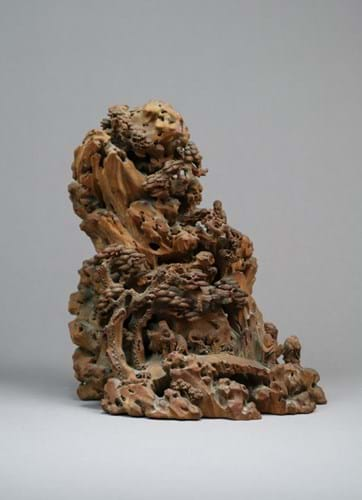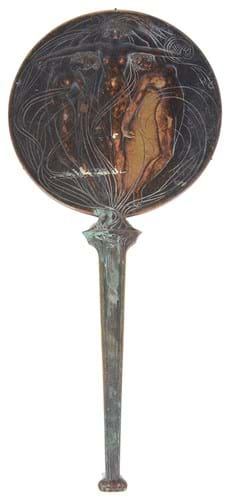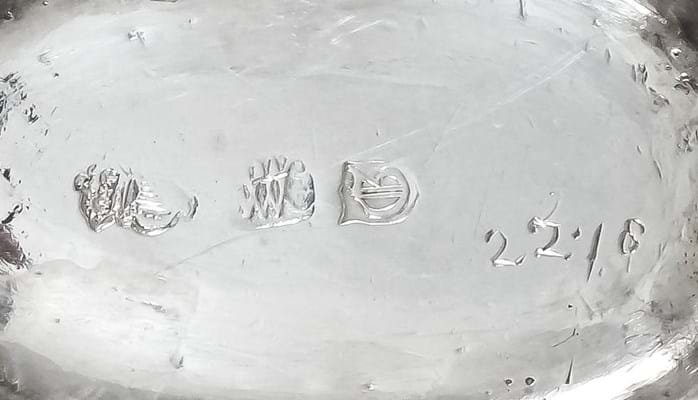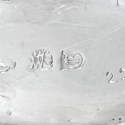1. Edmund de Waal’s netsuke collection
A welcome addition to the November 21 Asian Works of Art sale at Matthew Barton (24% buyer’s premium) of 25 Blythe Road in west London were 79 netsuke from the collection belonging to Edmund de Waal, author of the bestselling memoir The Hare with Amber Eyes. London Japanese art dealer Max Rutherston helped organise the sale and took this section of the auction.
The hammer total, just shy of £80,000 and close to three times the high estimate, will be donated by de Waal to the Refugee Council with this large ivory netsuke of a monkey and her young c.1800 leading proceedings at £3200. Eighteen of the pieces were bought by the owner of the house in Tunbridge Wells where de Waal’s great-grandparents lived after fleeing persecution in 1939. The majority of the collection, including the hare referred to in the title of the book, has been placed by the family on long-term loan in the Jewish Museum in Vienna.
2. Qing-period scholar’s bamboo root carving
This typical Qing period scholar’s object – a 9in (23cm) bamboo root carving worked as a rocky outcrop populated by sages amid gnarled pines – took an unexpected £35,000 after a bidding battle between multiple phones and online at Halls (20% buyer’s premium) of Shrewsbury on November 28. It had come for sale, with some small losses to figures and tree branches, with an estimate of £400-600.
3. Lalique bronze hand mirror
Entered for sale by a gentleman who, as a dustman in the 1970s, had found it on his rounds, this Lalique bronze hand mirror by René Lalique c.1910, sold for £7500 in Catherine Southon’s (18% buyer’s premium) sale at Farleigh Court Golf Club, Selsdon in Surrey on November 28. Cast with the Three Graces among swirls and the handle cast with a devil, the mirror was stamped on the side Lalique. It was not in the best condition but the price was more than 17 times its estimate.
4. Spanish silver Philip IV coin
Silver 50 reale coins or cincuentines were issued in extremely limited numbers. Such was the size of the denomination – known at the time as ‘monedas excelentes’ that in some years between 1609 and 1683 as few as 20 examples were minted to be used only as prestige pieces given as a mark of favour to courtiers, noblemen and members of the royal family. This ‘extremely fine’ Philip IV (1621-65) coin was minted in 1635. It includes the crowned Habsburg shield of arms and an aqueduct denoting the Segovia Mint and the letter R below denoting the assayer Rafael Savan. Thought to have been acquired in 1966 for £130, it sold for £34,000 at Morton & Eden (20% buyer’s premium), London on November 28.
5. Late Stuart and early Georgian silver
The nine lots of late Stuart and early Georgian silver that opened the sale at Canterbury Auction Galleries (24% buyer’s premium) on November 27 came for sale from the descendants of Lieutenant Colonel John N Price Wood (1877-1962). They included this rare pair of 44oz George I double-lipped sauce boats with marks for Matthew Walker, Dublin 1726 that, estimated at £3500-5000, sold at £57,000.
The price reflected their Irish marks, a scarce form, Huguenot styling including with cut card panels engraved with stag's head crests and relatively little wear with scratch weights 22.8 and 23.0 still clearly visible to the base.
Raised at Wirksworth Hall in Derbyshire (demolished in 1920), Wood had served in the 12th Lancers in the Boer War, receiving the Queen’s South Africa Medal with clasps for Johannesburg, Diamond Hill, Wittenbergen and the Relief of Kimberley. After returning home to more leisurely pursuits he penned the book Travel & Sport in Turkestan (published 1910), and moved to Henley Hall, Bitterley, Shropshire.


